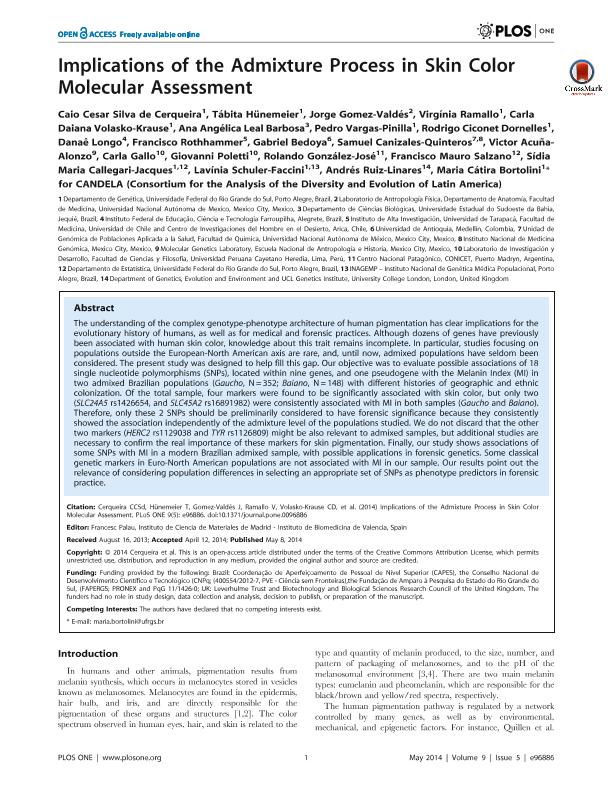Artículo
Implications of the admixture process in skin color molecular assessment
Silva de Cerqueira, Caio Cesar ; Hünemeier, Tábita; Gomez Valdés, Jorge; Ramallo, Virginia
; Hünemeier, Tábita; Gomez Valdés, Jorge; Ramallo, Virginia ; Volasko Krause, Carla Daiana; Leal Barbosa, Ana Angélica; Vargas Pinilla, Pedro; Ciconet Dornelles, Rodrigo; Longo, Danaê; Rothhammer, Francisco; Bedoya Berrío, Gabriel; Canizales Quinteros,Samuel; Acuña Alonzo, Victor; Gallo, Carla; Poletti, Giovann; González José, Rolando
; Volasko Krause, Carla Daiana; Leal Barbosa, Ana Angélica; Vargas Pinilla, Pedro; Ciconet Dornelles, Rodrigo; Longo, Danaê; Rothhammer, Francisco; Bedoya Berrío, Gabriel; Canizales Quinteros,Samuel; Acuña Alonzo, Victor; Gallo, Carla; Poletti, Giovann; González José, Rolando ; Salzano, Francisco Mauro; Callegari Jacques, Sídia Maria; Schuler Faccini, Lavínia; Ruiz Linares, Andrés; Bortolini, Maria Catira
; Salzano, Francisco Mauro; Callegari Jacques, Sídia Maria; Schuler Faccini, Lavínia; Ruiz Linares, Andrés; Bortolini, Maria Catira
 ; Hünemeier, Tábita; Gomez Valdés, Jorge; Ramallo, Virginia
; Hünemeier, Tábita; Gomez Valdés, Jorge; Ramallo, Virginia ; Volasko Krause, Carla Daiana; Leal Barbosa, Ana Angélica; Vargas Pinilla, Pedro; Ciconet Dornelles, Rodrigo; Longo, Danaê; Rothhammer, Francisco; Bedoya Berrío, Gabriel; Canizales Quinteros,Samuel; Acuña Alonzo, Victor; Gallo, Carla; Poletti, Giovann; González José, Rolando
; Volasko Krause, Carla Daiana; Leal Barbosa, Ana Angélica; Vargas Pinilla, Pedro; Ciconet Dornelles, Rodrigo; Longo, Danaê; Rothhammer, Francisco; Bedoya Berrío, Gabriel; Canizales Quinteros,Samuel; Acuña Alonzo, Victor; Gallo, Carla; Poletti, Giovann; González José, Rolando ; Salzano, Francisco Mauro; Callegari Jacques, Sídia Maria; Schuler Faccini, Lavínia; Ruiz Linares, Andrés; Bortolini, Maria Catira
; Salzano, Francisco Mauro; Callegari Jacques, Sídia Maria; Schuler Faccini, Lavínia; Ruiz Linares, Andrés; Bortolini, Maria Catira
Fecha de publicación:
08/05/2014
Editorial:
Public Library of Science
Revista:
Plos One
ISSN:
1932-6203
Idioma:
Inglés
Tipo de recurso:
Artículo publicado
Clasificación temática:
Resumen
The understanding of the complex genotype-phenotype architecture of human pigmentation has clear implications for the evolutionary history of humans, as well as for medical and forensic practices. Although dozens of genes have previously been associated with human skin color, knowledge about this trait remains incomplete. In particular, studies focusing on populations outside the European-North American axis are rare, and, until now, admixed populations have seldom been considered. The present study was designed to help fill this gap. Our objective was to evaluate possible associations of 18 single nucleotide polymorphisms (SNPs), located within nine genes, and one pseudogene with the Melanin Index (MI) in two admixed Brazilian populations (Gaucho, N = 352; Baiano, N = 148) with different histories of geographic and ethnic colonization. Of the total sample, four markers were found to be significantly associated with skin color, but only two (SLC24A5 rs1426654, and SLC45A2 rs16891982) were consistently associated with MI in both samples (Gaucho and Baiano). Therefore, only these 2 SNPs should be preliminarily considered to have forensic significance because they consistently showed the association independently of the admixture level of the populations studied. We do not discard that the other two markers (HERC2 rs1129038 and TYR rs1126809) might be also relevant to admixed samples, but additional studies are necessary to confirm the real importance of these markers for skin pigmentation. Finally, our study shows associations of some SNPs with MI in a modern Brazilian admixed sample, with possible applications in forensic genetics. Some classical genetic markers in Euro-North American populations are not associated with MI in our sample. Our results point out the relevance of considering population differences in selecting an appropriate set of SNPs as phenotype predictors in forensic practice.
Palabras clave:
Snps
,
Genotype-Phenotype
,
Human Pigmentation
Archivos asociados
Licencia
Identificadores
Colecciones
Articulos(CCT-CENPAT)
Articulos de CTRO.CIENTIFICO TECNOL.CONICET - CENPAT
Articulos de CTRO.CIENTIFICO TECNOL.CONICET - CENPAT
Articulos(IMBICE)
Articulos de INST.MULTIDISCIPL.DE BIOLOGIA CELULAR (I)
Articulos de INST.MULTIDISCIPL.DE BIOLOGIA CELULAR (I)
Citación
Silva de Cerqueira, Caio Cesar; Hünemeier, Tábita; Gomez Valdés, Jorge; Ramallo, Virginia; Volasko Krause, Carla Daiana; et al.; Implications of the admixture process in skin color molecular assessment; Public Library of Science; Plos One; 9; 5; 8-5-2014; 1-7; e109451
Compartir
Altmétricas



